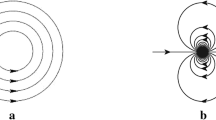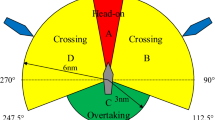Abstract
Autonomous navigation on the open sea involving automatic collision avoidance and route planning helps to ensure navigational safety. To judge whether all target ships (TSs) will pass safely and find the optimal route under multi-ship encounter situations, the relationship between the variations in the own ship (OS) velocity vector after nonlinear course altering motion and the collision avoidance result, which is defined as the collision avoidance mechanism, was analyzed. Methods producing the optimal route were also proposed. First, the static collision avoidance mechanism based on the ship domain and velocity obstacle (VO) was introduced. On that basis, the collision-free course alteration range of the OS, without consideration of the real manoeuvring process, was presented. Second, the ship motion equations and fuzzy adaptive proportion integral derivative (PID) control method were combined to develop a course control system. This system was then used to predict OS motions during the course-altering process. Based on this prediction, TS positions were calculated. Subsequently, the dynamic collision-free course altering ranges for the OS were obtained. Third, a model to compute the optimal route was introduced. Finally, simulations were performed under a situation including six TSs and two static objects, and the shortest collision-free route that satisfies both regulations for preventing collisions and good seamanship was found.















Similar content being viewed by others
References
Bi X, Liu X (2015) Research on double collision avoidance mechanism of ships at sea. Int J Mar Navig Saf Sea Transp 9(1):13–16
Calvert E (1960) Manoeuvres to ensure the avoidance of collision. J Navig 50(3):400–410
Candeloro M, Lekkas A, Hegde J, Asgeir J, Sørensen (2016) A 3D dynamic Voronoi diagram-based path-planning system for UUVs. In: OCEANS’16 MTS/IEEE Monterey. IEEE
Candeloro M, Lekkasa A, Sørensen A (2017) A Voronoi-diagram-based dynamic path-planning system for underactuated marine vessels. Control Eng Pract 61:41–54
Chen L, Hopman H, Negenborn R (2018) Distributed model predictive control for vessel train formations of cooperative multi-vessel systems. Transp Res Part C 92:101–118
Chen P, Huang Y, Mou J et al (2018) Ship collision candidate detection method: a velocity obstacle approach. Ocean Eng 170:186–198
Chen P, Huang Y, Mou J et al (2019) Probabilistic risk analysis for ship-ship collision: state-of-the-art. Saf Sci 117:108–122
China Classification Society (2015) Rules for intelligent ships. China Classification Society, Beijing
Cho Y, Han J, Kim J (2018) Intent inference of ship maneuvering for automatic ship collision avoidance. IFAC Pap On Line 51–29:384–388
Davis P, Dove M, Stockel C (1980) A computer simulation of marine traffic using domains and arenas. J Navig 33(2):215–222
Degre T, Lefevre X (1981) A collision avoidance system. J Navig 34(2):294–302
Fiorini P (1998) Motion planning in dynamic environments using velocity obstacles. Int J Robot Res 17(7):760–772
Fujii Y, Tanaka K (1971) Traffic capacity. J Navig 24(4):543–552
Goodwin E (1975) A statistical study of ship domains. J Navig 28:328
He Y, Huang L, Mou J (2014) Automatic collision avoidance for ships approaching head-on with MMG and ship domain. Navig China 4:92–95
He Y, Huang L, Mou J, Xiong Y (2015) A scheme for automatic collision avoidance of give-way vessel in the crossing situation. J Harbin Eng Univ 8:1024–1029
He Y, Jin Y, Huang L et al (2017) Quantitative analysis of COLREG rules and seamanship for autonomous collision avoidance at open sea. Ocean Eng 140(2017):281–291
Huang Y, van Gelder P, Wen Y (2018) Velocity obstacle algorithms for collision prevention at sea. Ocean Eng 151:308–321
Jones K (1974) Application of a maneuver diagram to multi-ship encounters. J Navig 27(1):19–27
Liu C, Negenborn R, Chu X, Zheng H (2018) Predictive path following based on adaptive line-of-sight for underactuated autonomous surface vessels. J Mar Sci Technol 23:483–494
Liu J (2011) Advanced PID control MATLAB simulation. Publishing House of Electronics Industry
Ma Y, Zhu G, Li Z (2019) Error-driven-based nonlinear feedback recursive design for adaptive nn trajectory tracking control of surface ships with input saturation. Intell Transp Syst Mag 11(2):17–28
Mitrofanov (1968) An anti-collision indicator. J Navig 02:163–170
Mou J, Tak C, Ligteringen H (2010) Study on collision avoidance in busy waterways by using AIS data. Ocean Eng 37:483–490
Pedersen E, Kinzo I, Masanori T (2002) Evaluation of a radar plot and display technique for anti-collision assessment to multiple targets in true vector representation by application of the environmental stress model. J Jpn Inst Navig 106:1–12
Polvara R, Sharma S, Wan J, Manning A, Sutton R (2018) Obstacle avoidance approaches for autonomous navigation of unmanned surface vehicles. J Navig 71:241–256
Praczyk T (2015) Neural anti-collision system for autonomous surface vehicle. Neurocomputing 149:559–572
Qin Z, Lin Z, Yang D, Li P (2017) A task-based hierarchical control strategy for autonomous motion of an unmanned surface vehicle swarm. Appl Ocean Res 65:251–261
Ren Y, Mou J, Du Y, Zhu J (2012) Study on ship domain using AIS data. The international workshop on next generation of nautical traffic model
Singh Y, Sharma S, Sutton R, Hatton D, Khan A (2018) A constrained A* approach towards optimal path planning for an unmanned surface vehicle in a maritime environment containing dynamic obstacles and ocean currents. Ocean Eng 169:187–201
Tang P, Zhang R, Liu D, Huang L, Liu G, Deng T (2015) Local reactive obstacle avoidance approach for high-speed unmanned surface vehicle. Ocean Eng 106:128–140
Wang H (2016) Design of ship course controller based on fuzzy adaptive PID control. Ind Control Comput 3:86–87
Wu B, Xiong Y, Wen Y (2014) Automatic collision avoidance algorithm for unmanned surface vessel based on velocity obstacles. J Dalian Marit Univ 2:13–16
Xiong Y, He Y, Huang L (2015) Multi-ship collision avoiding control considering velocity obstacle. Navig China 3:46–51
Xue Y, Lee B, Han D (2008) Automatic collision avoidance of ships. Proc Inst Mech Eng Part M J Eng Marit Environ 223(1):33–46
Xu Q, Yang Y, Zhang C, Zhang L (2018) Deep convolutional neural network-based autonomous marine vehicle maneuver. Int J Fuzzy Syst 20(2):687–699
Zhang J, Yan X, Chen X, Chu X (2012) Analysis of traffic accidents on the Yangtze river trunk line based on probability distribution. Navig China 3:81–84
Zhang R, Furusho M (2016) Constructing a decision-support system for safe ship-navigation using a Bayesian network. In: International Conference on Digital Human Modeling and Applications in Health, Safety, Ergonomics and Risk Management. Springer, Cham, pp 616–628
Zhang X (2018) Real-time dynamic path planning of ship base on coupled collision avoidance mechanism. Wuhan University of Technology
Zhao Y, Li W, Shi P (2016) A real-time collision avoidance learning system for unmanned surface vessels. Neurocomputing 182:255–266
Zhou D (2017) Research on a novel dynamic and fuzzy ship domain. Dalian Maritime University, 2017
Acknowledgements
The work presented in this study is financially supported by Classification of Project (2019YFB1600603), National Natural Science Foundation China (51579201), the Transportation Science and Technology Project of Jiangsu Province (2018Z01), Independent Innovation Fund for Graduate Students of Wuhan University of Technology (175212004) and the Open Foundation of Nation Water Transportation Safety Engineering Technical Centre (185212007). The authors would like to sincerely thank Dr. Jinhui Li at Guangdong University of Foreign Studies for improving this manuscript in language. Special thanks go to the anonymous reviewers for their good and constructive comments, ideas and suggestions, which are substantial to improve our research.
Author information
Authors and Affiliations
Corresponding author
Additional information
Publisher's Note
Springer Nature remains neutral with regard to jurisdictional claims in published maps and institutional affiliations.
About this article
Cite this article
Junmin, M., Mengxia, L., Weixuan, H. et al. Mechanism of dynamic automatic collision avoidance and the optimal route in multi-ship encounter situations. J Mar Sci Technol 26, 141–158 (2021). https://doi.org/10.1007/s00773-020-00727-4
Received:
Accepted:
Published:
Issue Date:
DOI: https://doi.org/10.1007/s00773-020-00727-4




